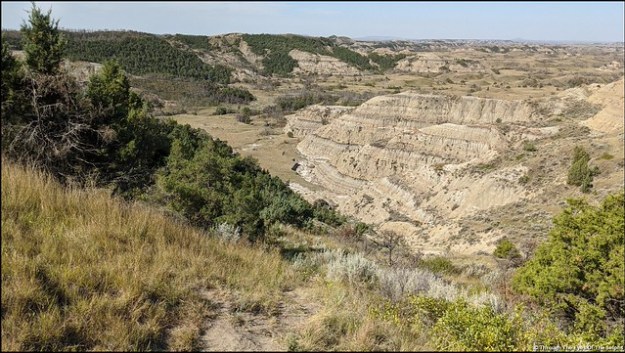We left Pierre SD under rainy skies on a fast track to Oklahoma City. The weather quickly changed from sunny, hot weather in Pierre to rain, wind and falling temperatures.
We stopped to see the “Dignity of Earth and Sky” sculpture, conveniently located at a rest area off the interstate. The Native American woman is standing high on a bluff above the Missouri River. The star quilt is made of 128 diamond shapes in the colors of water and sky. The statue is 50 feet tall, weighs 12 tons and is made of hundreds of pieces of stainless steel. She honors the Native Nations of the Great Plains. I bet it would have been beautiful to see on a sunny day. 

The welcome center had a Lewis and Clark exhibit. 


By the time we reached our first overnight stop in Pickstown, South Dakota the wind was almost blowing us off our feet and it was cold. 
The next morning we awoke to more rain and wind and headed to Stromsburg, Nebraska, also known as the Swede capital of Nebraska. The persistent rain followed us with high temperatures in the upper 40’s. Miserably damp and cold. It probably would have been a nice little town to explore if we had more time and the weather had been better. We were parked in their free RV park under trees and the heavy rain dripping off the leaves was loud throughout the night. 

We were up early the next day and drove to McPherson, Kansas where we arrived in a driving rain. Horrible conditions for Bill to hook everything up outside. We were beginning to think we would never be warm or dry again.
After several days we headed to Oklahoma City for a five night stay. The rain had finally stopped and it warmed up! 


There were several places to visit in this busy capital city with lots of traffic. We first visited the Oklahoma City National Memorial, the site of the horrific bombing on April 19, 1995. It is a beautiful, moving memorial including “The Gates of Time” marking the moment of destruction at 9:02 AM. 



The “Field of Empty Chairs” is arranged in nine rows reflecting the floors where the victims were located. The 168 chairs are each etched with the name of the person killed, including 19 smaller chairs representing children. 


A “Survivor Wall” is located on the building’s only remaining walls with the names of more than 600 people who survived the blast. 
Nearby was a statue entitled “Jesus Wept”. 
Next we went to visit the Oklahoma state capitol building, another new one for us. 





Well we sort of saw the building. All year the pandemic has handicapped our travel plans. This time it wasn’t the pandemic, but a $193 million multi year renovation. We were able to visit the building, but most of it was off limits. 



More than 100 paintings, statues and busts had all been removed. We did the best we could to get a flavor for what the building looks like. I bet it will be beautiful when it is finished in 2022. 




This is the only capitol building in the world surrounded by working oil wells. One well is called “Petunia #1” because it was drilled in the middle of a flower bed. 

Another interesting place was the Centennial Land Run Monument” which commemorates the opening of unassigned land in the Oklahoma Territory in 1889. Over 50,000 men and women made a rush to claim the land. People who didn’t wait for the official opening of the land and illegally grabbed the land early were called “sooners”. The frenzied energy and emotion of the run was captured in bronze statues. It is one of the world’s largest group of bronze sculptures and features 45 figures. 


Next up: Time for a Change and Exciting News






























































































































































































































































